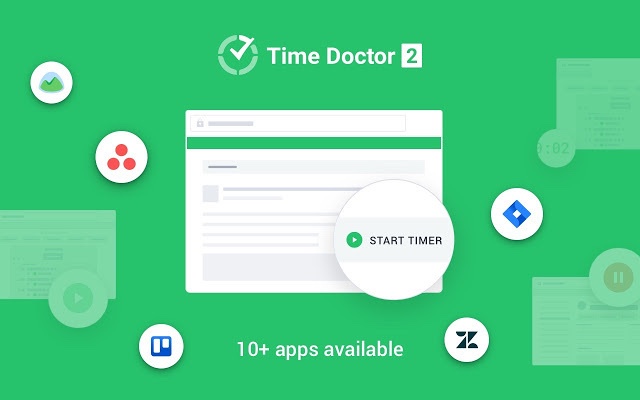Many people tend to work for long hours due to distraction, procrastination, and poor time management.
And the only way to revert to healthy work hours and get things done efficiently is to master the skill of time management.
But how do you start managing time?
Simple: by creating a solid time management plan.
In this article, we’ll discuss how to create an effective time management plan for your needs. We’ll also reveal nine simple tips for better time management.
This article contains:
(Click on the links below to jump to a specific section)
Let’s begin!
6 steps to develop a great time management plan
Here’s a 6-step guide to create a good time management plan that’ll help you make the most of your time:
Step 1: List down your tasks
Every time management plan starts with the fundamental step of listing down all the tasks that need your attention.
While doing this, have a clear idea of what you’d like to achieve from your daily and weekly schedule.
If you have a complex task, you can use project management tools such as a work breakdown structure (WBS) to help you out. The tool takes into account project costs, deliverables, and team coordination while breaking down large projects into manageable tasks.
This way, you can break and divide your complex tasks into smaller tasks among your team members. With WBS, teams can work in tandem, ensure their project is within budget, and identify milestones.
Additionally, the task list should also include tasks that would help you achieve your long term goal.
For example, if you’re an employee and art is your hobby, your to do list should contain work projects as well as your creative sessions. This way, you can create an effective time management plan that’ll give you enough time to follow work and personal life goals without tiring yourself.
Also, remember to keep updating the task list throughout the day as you come across new tasks.
Step 2: Prioritize tasks
Not all tasks share the exact due dates or difficulty levels. That’s why it’s important to prioritize tasks according to their urgency or complexity levels.
The Eisenhower Matrix is a framework you can follow while prioritizing tasks to help distinguish important tasks from unimportant ones.
According to the matrix, you can define activities into four categories:
| Urgent Task | Non Urgent Task | |
| Important | Do It Now Tasks with clear deadlines and consequences | Schedule ItTasks without a set deadline but will help you achieve your overall goals. |
| Not Important | Delegate It Tasks that don’t necessarily require your specific skills or intervention | Delete ItDistractions that only make you feel good in the short term. |
Another time management technique to prioritize tasks is to follow the Mark Twain-inspired ‘eat the frog’ method. Some challenging tasks may take more time than necessary and tackling them first thing each morning is the best way to move forward in the project.
This technique will rewire your brain to believe that you can easily handle complex tasks. So every time you take one on, you become better at dealing with challenges!
Step 3: Schedule tasks
To create a daily or weekly schedule that you’re most likely to follow, set a time limit for every task on your list.
For example, you can schedule 10 minutes to return important calls, an hour for project research, 20 minutes for meetings, and so on.
When you finish a task under a specific time duration, even the most unpleasant one becomes easier to do. So scheduling tasks into time slots will help you stay organized, efficient, and focussed on your work – without getting overwhelmed by your long to-do lists.
Additionally, take note of your productive hours. For instance, some people are most productive in the morning while others work better post-noon. If you too have a specific window, schedule important tasks in those hours to get them done faster.
Step 4: Schedule discretionary time
Discretionary time refers to the free time that’s not assigned to any task. It includes the planned discretionary time and time gaps in your planner.
For example, if your meeting ends an hour earlier than predicted, you have a discretionary time of one hour. You can either schedule this extra time to complete your tasks or use it to take a break, meditate, review your schedule, check emails, etc.
But always remember, unexpected events are bound to happen. Setting aside some free time will prepare you for the unanticipated task.
Step 5: Note your distractions
Distractions can keep you from giving your best at work. They can be small habits that go unnoticed, like frequently checking notifications or social media, procrastinating, etc.
As a result, it’s important to anticipate and list your distractions, including unavoidable personal commitments, while you schedule your project task.
This way, you can create an efficient time management plan around these commitments and mindfully eliminate your distractions.
Step 6: Invest in time management tools
With the right tools, you can check your progress on a project task without manually tracking time, helping you focus fully on work.
Time management tools like Time Doctor can help you time and track your working hours to ensure you’re using it productively.
What is Time Doctor?

Time Doctor is a powerful productivity and time management tool preferred by large businesses like Ericsson as well as small ones like Thrive Market.
Here are Time Doctor’s unique features that’ll help you create a time management plan:
- The time tracker tracks how much time you spend on monthly, weekly, and daily tasks. Time Doctor’s idle time tracker will also alert you on your inactive minutes.
- The comprehensive reports and analytics provide detailed insights into how you spend your scheduled hours and automate administrative tasks like billing, attendance, etc.
- The work scheduling feature lets you create and edit work schedules within the app.
- The app and website report feature show the applications and sites used during work hours.
- The Chrome extension offers integrations with other platforms such as Asana, ZohoProjects, GitHub, etc. The extension inserts a button in the third-party app for you to start tracking time.
Now, let’s check out some helpful tips and tricks to enhance the effectiveness of your time management plan.
9 simple and effective time management tips
Here are some time management tips and fixes to improve your management skills:
1. Time yourself
Time your daily tasks to estimate the duration of each activity instead of scheduling them blindly.
This’ll also tell you if you’re spending too much time on certain projects. You can then consciously reduce your time to accommodate more tasks.
If you aren’t sure about your time estimates, compare similar tasks from the past to get an idea.
For example, if it takes you an hour to make a 30-minute presentation, you can predict that it’ll take around two hours to make an hour-long presentation.
2. Practice time blocking
Time blocking is a management technique that lets you divide your day into small blocks of time. Each time block is assigned a specific task from the to-do list on a priority basis. And you should only focus on the planned activity during a time block.
To employ this technique, you’ll need a complete list of prioritized tasks from which you can schedule work to different time blocks.
You’ll not only schedule tasks but also have the motivation to finish them since each time block acts as a deadline – pushing you to work faster.
Besides, this technique also eliminates procrastination and distractions as you have a defined start and finish point for a task, helping you focus better.
3. Employ Rapid Planning Method
The Rapid Planning Method (RPM) calls for a result-oriented, purpose-driven, and massive action time management plan.
According to the RPM process, you need to ask yourself these three questions before taking up an assignment:
- What do you really want?
- Why does it matter to you?
- How will you achieve it?
These questions will help you manage time, sharpen your time management skills, and work strategically towards achieving the desired goal in your life.
4. Spend your mornings on MITs
MIT refers to the Most Important Task that requires immediate attention.
Most people finish smaller tasks first, thinking it’ll save time. But this only drains them before they even get to the important task of the day. As a result, they’d take more time to complete their task lists.
Instead, start your workday with at least three MITs from your to do list. This way, you can complete your priority tasks, avoid last-minute rushes, and be more productive.

5. Learn to say no
Many believe it’s selfish to say ‘no.’ But it’s an invaluable time management skill that’ll give you enough time to focus on important tasks.
Why?
Saying yes to more work, meetings, family gatherings, etc., than you can take on may seem the easiest option. But you’ll be overwhelmed due to the heavy workload, experience increased stress levels, and suffer burnout.
For example, if you already have back-to-back meetings to attend and your colleague asks you to take one of theirs too, say no. If you say yes, you’ll have to prepare for both in less time, compromising the quality of the tasks at the last minute.
Instead, request your colleague to find someone with extra time to spare to take over the new meeting.
6. Stop multitasking
Multitasking may sound like a good time management strategy to get more done within a period.
However, research shows that multitasking affects your productivity by decreasing your workflow, attention span, and overall performance.
How?
Most of the time, when you think that you’re getting many things done simultaneously, you may be blindly shifting your focus from one task to another.
Multitasking will take your focus away from important tasks that need your full attention and affect your problem solving skills, thereby reducing your productivity.
Psychologists call this the ‘task switch cost.’
It refers to the negative effects of switching between tasks, such as a distraction, increased stress levels, slower working pace, etc. – resulting in poor time management.
For instance, if you’re trying to read a book while talking on the phone, you may likely have to reread the book if you’re focusing on the call and vice-versa.
So take a few minutes at the start of each workday to create an effective time management plan and tackle your scheduled tasks one by one to work efficiently.
7. Adopt the Swiss Cheese Method
You often come across high-priority tasks that overwhelm you, forcing you to avoid them or procrastinate.
The best time management technique to counter this problem is the Swiss Cheese Method. If you have an important task, make small holes in it by breaking it down into smaller tasks – just like the Swiss Cheese.
These instant tasks should take no longer than five minutes. And before you know it, you would’ve completed the entire task!
8. Master the 80-20 rule
The 80-20 rule (or the Pareto Principle) is the minor imbalance you need to create a good time management plan.
According to the rule, 80% of your results come from just 20% of your efforts or time.
For example:
- 80% of your sales may come from 20% of your products.
- 80% of decisions are made in 20% of your meeting slots.
This means that 20% of your tasks contribute around 80% of your success. But the key is in finding the right tasks to prioritize to achieve the results you want.
It may be difficult to distinguish such critical tasks from the urgent but unimportant ones that give us a fake feeling of progress. These tasks take a significant amount of time, giving us little time to tackle the important things.
Instead, use the 80-20 rule while prioritizing each weekly or daily schedule to help filter out the unimportant tasks. You can then employ the additional resources to focus on a specific task that’ll create a real impact.
9. Stick to an early deadline
Sometimes you may miscalculate the time needed for an activity, making it difficult to complete tasks on time.
To avoid this, set yourself an early deadline or create a good time management plan where you complete your tasks a day before the due dates.
At the end of the day, it’ll save you from unnecessary pressure and help you achieve your goal.
Wrapping up
Nobody wants to work around the clock.
So, to enjoy that much-deserved me-time, you need a well-prioritized time management plan to help you focus and enhance your productivity.
Use the tips covered in this article to create a solid time management plan and take control of your time. And finally, combine your plan and techniques with the right time management tool like Time Doctor.
Sign up for Time Doctor’s free trial today and save time, hit deadlines like a pro, and maintain a healthy work-life balance!

Vaishali Badgujar is a Content and SEO specialist at Time Doctor, an employee-friendly time-tracking system that boosts productivity.


